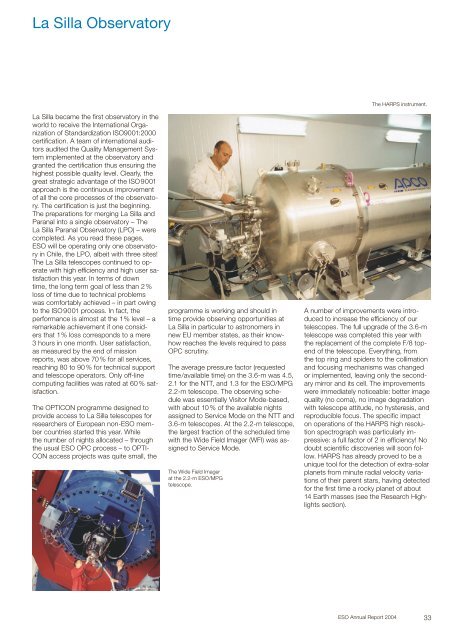ESO Annual Report 2004
ESO Annual Report 2004
ESO Annual Report 2004
- TAGS
- annual
- www.eso.org
Create successful ePaper yourself
Turn your PDF publications into a flip-book with our unique Google optimized e-Paper software.
La Silla Observatory<br />
La Silla became the first observatory in the<br />
world to receive the International Organization<br />
of Standardization ISO9001:2000<br />
certification. A team of international auditors<br />
audited the Quality Management System<br />
implemented at the observatory and<br />
granted the certification thus ensuring the<br />
highest possible quality level. Clearly, the<br />
great strategic advantage of the ISO9001<br />
approach is the continuous improvement<br />
of all the core processes of the observatory.<br />
The certification is just the beginning.<br />
The preparations for merging La Silla and<br />
Paranal into a single observatory – The<br />
La Silla Paranal Observatory (LPO) – were<br />
completed. As you read these pages,<br />
<strong>ESO</strong> will be operating only one observatory<br />
in Chile, the LPO, albeit with three sites!<br />
The La Silla telescopes continued to operate<br />
with high efficiency and high user satisfaction<br />
this year. In terms of down<br />
time, the long term goal of less than 2 %<br />
loss of time due to technical problems<br />
was comfortably achieved – in part owing<br />
to the ISO9001 process. In fact, the<br />
performance is almost at the 1% level – a<br />
remarkable achievement if one considers<br />
that 1% loss corresponds to a mere<br />
3 hours in one month. User satisfaction,<br />
as measured by the end of mission<br />
reports, was above 70 % for all services,<br />
reaching 80 to 90 % for technical support<br />
and telescope operators. Only off-line<br />
computing facilities was rated at 60 % satisfaction.<br />
The OPTICON programme designed to<br />
provide access to La Silla telescopes for<br />
researchers of European non-<strong>ESO</strong> member<br />
countries started this year. While<br />
the number of nights allocated – through<br />
the usual <strong>ESO</strong> OPC process – to OPTI-<br />
CON access projects was quite small, the<br />
programme is working and should in<br />
time provide observing opportunities at<br />
La Silla in particular to astronomers in<br />
new EU member states, as their knowhow<br />
reaches the levels required to pass<br />
OPC scrutiny.<br />
The average pressure factor (requested<br />
time/available time) on the 3.6-m was 4.5,<br />
2.1 for the NTT, and 1.3 for the <strong>ESO</strong>/MPG<br />
2.2-m telescope. The observing schedule<br />
was essentially Visitor Mode-based,<br />
with about 10 % of the available nights<br />
assigned to Service Mode on the NTT and<br />
3.6-m telescopes. At the 2.2-m telescope,<br />
the largest fraction of the scheduled time<br />
with the Wide Field Imager (WFI) was assigned<br />
to Service Mode.<br />
The Wide Field Imager<br />
at the 2.2-m <strong>ESO</strong>/MPG<br />
telescope.<br />
A number of improvements were introduced<br />
to increase the efficiency of our<br />
telescopes. The full upgrade of the 3.6-m<br />
telescope was completed this year with<br />
the replacement of the complete F/8 topend<br />
of the telescope. Everything, from<br />
the top ring and spiders to the collimation<br />
and focusing mechanisms was changed<br />
or implemented, leaving only the secondary<br />
mirror and its cell. The improvements<br />
were immediately noticeable: better image<br />
quality (no coma), no image degradation<br />
with telescope attitude, no hysteresis, and<br />
reproducible focus. The specific impact<br />
on operations of the HARPS high resolution<br />
spectrograph was particularly impressive:<br />
a full factor of 2 in efficiency! No<br />
doubt scientific discoveries will soon follow.<br />
HARPS has already proved to be a<br />
unique tool for the detection of extra-solar<br />
planets from minute radial velocity variations<br />
of their parent stars, having detected<br />
for the first time a rocky planet of about<br />
14 Earth masses (see the Research Highlights<br />
section).<br />
<strong>ESO</strong> <strong>Annual</strong> <strong>Report</strong> <strong>2004</strong><br />
The HARPS instrument.<br />
33

















